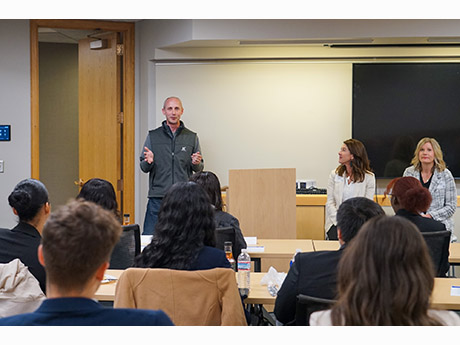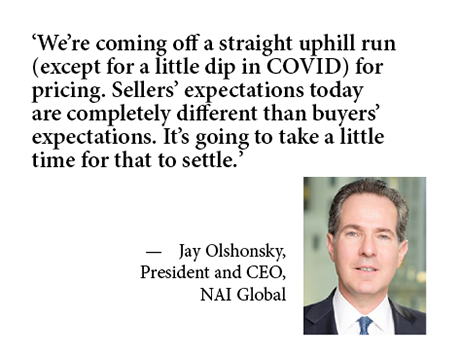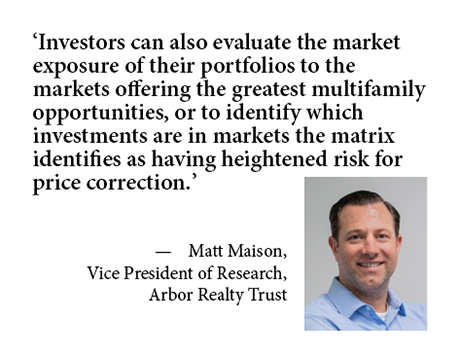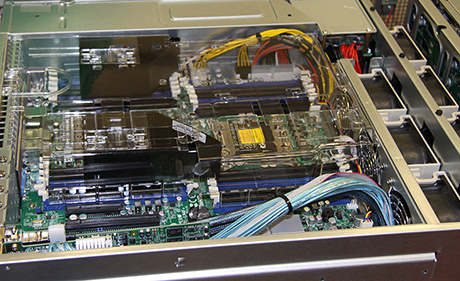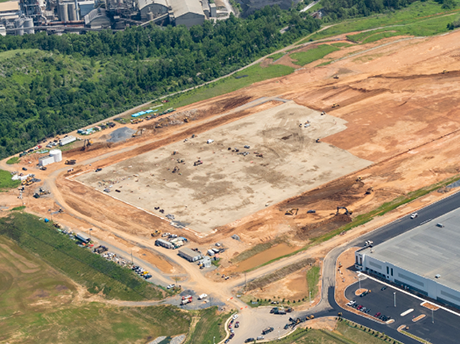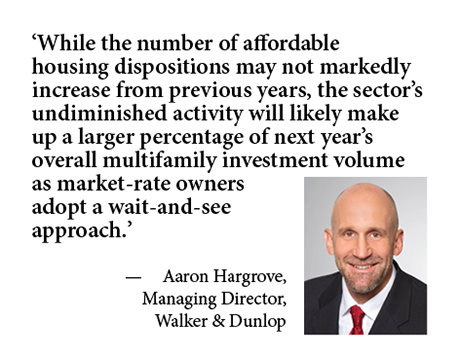By John Ducey, chief production officer of Walker & Dunlop’s affordable lending group Private industry and the federal government are rallying to recover ground lost to a housing affordability crisis that has been decades in the making. Nearly half of the nation’s renters, 46 percent, are housing cost-burdened, which the Census Bureau defines as those families paying 30 percent or more of their income on rent and utilities. The burden is higher for some, with nearly one in four families (23 percent of Americans) paying half or more of their income for housing. The situation calls for a change in tactics, a recognition of recent policy failures and a shared commitment to double down on programs with proven efficacy. As a nation we must ask, what can we do differently to put more homes within reach for the growing ranks of Americans who struggle to meet basic housing costs? A Building Problem The gap between housing costs and strained household budgets has widened due to both insufficient supply and wage stagnation that has fueled demand for affordable housing. The larger of the two issues — a lack of supply — traces chiefly to the 2008 financial crisis, which put a …
Content Partner
Affordable HousingContent PartnerDevelopmentFeaturesLeasing ActivityMidwestMultifamilyNortheastSoutheastTexasWalker & DunlopWestern
Content PartnerFeaturesLeasing ActivityMidwestMultifamilyNortheastPavlov MediaSoutheastStudent HousingTexasWestern
The Evolution of Internet Setups: How Student Housing Internet Preferences Are Influencing Traditional Multifamily
Multifamily properties have witnessed a rapid expansion in Internet needs, a trend presaged by burgeoning Internet demands in student housing. Multifamily residents have increased their connection demands and are becoming increasingly sophisticated in their requirements for high-quality Internet. What can the lessons of student housing connectivity teach us about traditional multifamily trends, especially when it comes to bulk Internet? Bulk Internet approaches allow for more sophistication in multifamily properties, as demonstrated by student housing best practices. Student housing pioneered built-in networks to keep mobile devices from competing for Wi-Fi bandwidth, minimize downtime and use fiber connections to ensure speed and reliability. This style of network is becoming the gold standard for constant, heavy-duty Internet use in multi-dwelling units (MDUs). High-level connectivity is becoming an absolute necessity for multifamily properties, drawing in residents and improving their Internet-driven lifestyles. And as never-before-seen demand for bandwidth is graduating from dorm rooms to traditional apartments, well-planned multifamily Internet connections can help operators adapt gracefully. COVID’s Role in Internet Use Expansion COVID lockdowns accelerated already growing Internet requirements, which pushed Internet quality to the forefront as connectivity became increasingly important. “COVID put the spotlight on properties to make sure they had great infrastructure. The demand …
Content PartnerDevelopmentFeaturesIndustrialMidwestMixed-UseMultifamilyNortheastNorthmarqOfficeRetailSoutheastTexasWestern
Project Destined: Training a New and Diverse Generation for Real Estate Careers
For the better part of the last two decades, billions of dollars have poured into underserved neighborhoods across the U.S. as corporations, millennials and real estate investors rediscovered downtowns and other urban districts. But to former Carlyle Group executive Cedric Bobo and real estate entrepreneur Fred Greene, young people who grew up in the neighborhoods were often excluded from playing a role in the transitions. To remedy that problem, in 2016 they began training 15 Detroit high school students in real estate fundamentals and invested $150,000 to buy two properties with the idea of using the cash flow to fund scholarships. Soon after, Bobo and Greene officially launched Project Destined, an endeavor to effect social change in the commercial real estate industry by providing college students with financial literacy, entrepreneurship and real estate training. “Cedric found that there was a real need for diverse talent in commercial real estate but that it was hard for companies to find it,” reports Cristina Ciacciarelli, a junior at Burach College in New York City who completed the program in 2021 and now heads up corporate partnerships for Project Destined. “It was also hard for the companies to sell themselves to diverse talent even …
Content PartnerFeaturesIndustrialLeasing ActivityLoansMidwestMultifamilyNAINortheastOfficeRetailSoutheastTexasWestern
Experts Turn to Opportunistic Moves, Lending During Uncertainty of Economic Downturn
As we shift through economic uncertainty and changes in the market, commercial real estate businesses are planning for a range of scenarios — and looking to historical trends to make predictions. REBusinessOnline sat down with two industry experts to talk about how this period of uncertainty compares to previous eras and where there may be benefits and opportunities in the current landscape. Jay Olshonsky, president and CEO, and Cliff Moskowitz, executive vice president, at NAI Global spoke about the commercial real estate outlook and the challenges it is likely to face in the immediate future. REBusiness: Looking at the current environment, how does it compare to previous periods of uncertainty? What might be the impacts on commercial real estate? Olshonsky: To start with, we are in a recession. We’ve already had two quarters of negative GDP growth. I think the most fundamental difference between this cycle and a lot of other cycles is that we have extremely low unemployment, differentiating this moment from others, for example, 2009. Even though the most recent job numbers were lower, they were still fairly strong. Jobs create the demand for commercial real estate at all levels, but especially at the services level. We do …
AcquisitionsContent PartnerDevelopmentFeaturesIndustrialLeasing ActivityLee & AssociatesMidwestMultifamilyNortheastOfficeRetailSoutheastTexasWestern
Lee & Associates’ Third-Quarter 2022 Economic Rundown by Sector
Lee & Associates’ newly released 2022 Q3 North America Market Report examines third-quarter 2022 industrial, office, retail and multifamily outlooks throughout the United States. This sector-based review of commercial real estate trends for the third quarter of the year examines the difficulties facing each asset class and where opportunities in the commercial real estate landscape may be emerging. Lee & Associates has made the full market report available here (with further breakdowns of factors like vacancy rates, market rents, inventory square footage and cap rates by city), but the summaries below provide high-level considerations of the overall health and obstacles for the industrial, office, retail and multifamily sectors. Industrial Overview: High Rent, Low Vacancy Everywhere North American industrial space availability is tight everywhere while rent growth and property prices remain near or have moved beyond historic highs. Through the third quarter, the United States’ vacancy rate settled at 4 percent, up 10 basis points from second quarter 2022. Average rents increased 11.4 percent year over year with gains of 19 percent in Miami, 18.7 percent in Southern California’s Inland Empire, 16 percent in Phoenix and 14.6 percent in Atlanta. Since the COVID lockdown in March of 2020, developers of U.S. logistics space have been …
AcquisitionsArbor Realty TrustContent PartnerFeaturesMidwestMultifamilyNortheastSoutheastTexasWestern
Multifamily Opportunity Matrix Reveals Most Promising Markets for Investors, Developers
By Arbor Realty Trust Inflationary environments set many investors’ minds to thinking about multifamily properties, which have tended to perform as well or better than other property types in the face of economic headwinds. Product type is no guarantee of success, however, and careful site selection is essential to ensure a project will have the renter demand and pricing power the owner needs to succeed. Arbor Realty Trust, in partnership with Chandan Economics, developed the opportunity matrix featured in Arbor’s Top Opportunities in Large Multifamily Investment Report 2022. The opportunity matrix helps clients navigate the nation’s apartment markets, enabling them to compare relative strengths from one metro to the next and identify those offering the greatest potential for development or investment. Its ranking system, which analyzes eight key categories, found the top three U.S. metro markets for large multifamily investment in 2022 are San Antonio, Kansas City and Las Vegas. “Reviewing what made these communities rise to the top of our 50-metro ranking will demonstrate how investors can use the matrix to compare the climates of opportunity in the markets in which they operate, or to suggest new fields of opportunity for their next venture,” said Matt Maison, vice president …
Fiber networks built with multifamily properties in mind offer network resilience while maximizing ROI for owners and operators. Well-constructed fiber networks are at the heart of meeting and exceeding residents’ growing Internet needs, especially when work-from-home culture and the constant need for online connection have made Internet slowdowns and downtime unacceptable for end users. Fiber can also strengthen connectivity across multifamily properties, shoring up the Wi-Fi services residents have come to know and on which they’ve come to depend. How does a national fiber network integrate with multifamily properties? By focusing just on the needs of the multi-dwelling unit (MDU). “Instead of building out 200-mile routes of duct and fiber, we build out ‘miracle miles’ in densely populated MDU areas. From that point, we’re able to easily grow or expand out from that area,” says Michael O’Linc, president of fiber services & campus communications at Pavlov Media. O’Linc stresses the importance of a more planned, methodical approach for MDUs. A network that serves multifamily buildings must be a network focused on backups and fail safes. The “miracle mile” method creates a main line with laterals — creating a ring shape as it expands. This approach to fiber makes networks easier to …
Can you dig it? Possibly, but site civil engineers can help determine if construction can rock on without running into rocky situations. Thorough site civil due diligence is the foundation for developing a project with minimal delays. Keeping land development projects moving forward — especially during construction — requires highly informed due diligence processes and expertise when it comes to approvals and plans. Site civil engineering design with constructability in mind can support general contractors while streamlining the overall bidding and construction process. But what are best practices when it comes to ensuring a successful project? REBusinessOnline spoke to two experts who specialize in high-quality construction documents: Benjamin Plumb, P.E. project manager, and Keith Simpson, director of engineering, work for Bohler, a land development consulting and technical design company. You Never Know What You’ll Find Before You Dig — However, These Tips Can Help Uncertainty is part of any development project, but Simpson outlines two scenarios that make up the majority of the challenges he sees: 1. Existing underground utilities that are not reflected in plans. 2. Soils that differ from what was expected from the geotechnical report. In some cases, slowdowns are unavoidable and will cause delays, but due diligence can …
Affordable HousingContent PartnerDevelopmentFeaturesLoansMidwestNortheastSoutheastTexasWalker & DunlopWestern
Shortage of Tax Credits, Higher Interest Rates Plague Affordable Housing
Forty-year-high inflation rates that are outpacing wage growth and eating away at personal income are exacerbating already outsized resident demand for affordable housing financed by the federal Low-Income Housing Tax Credit (LIHTC) program. But it seems that obstacles to supplying new units to meet that demand are only multiplying. Those range from a shortage of housing tax credits needed to fund new supply to resistance to multifamily development at the local level. Meanwhile, higher mortgage rates are making home buying more difficult and expensive. In turn, that is creating more apartment renters, thereby putting upward pressure on rental rates. In September, for example, the average monthly rent price nationwide hit $1,759, an increase of 7.8 percent from the prior year, according to Realtor.com’s monthly rental report. That’s also nearly 25 percent higher than September 2019, the organization reports. What’s more, from 2015 through 2020 — long before mortgage rates spiked — the U.S. lost 4.7 million apartment units with rents less than $1,000 per month, according to U.S. Apartment Demand Through 2035, a report by the National Multifamily Housing Council and National Apartment Association. “Demand for affordable units is only going to become more acute between now and the end of …
Affordable HousingContent PartnerFeaturesLeasing ActivityLoansMidwestMultifamilyNortheastSoutheastTexasWalker & DunlopWestern
Walker & Dunlop: Affordable Housing’s Appeal Grows for Investors
With transaction volume for market-rate housing beginning to ebb, affordable housing investment is poised to play a more central role in the months ahead. Several factors have broadened the allure of affordable housing as an investment vehicle in recent years. When the pandemic began taking a toll on market-rate housing performance, investors saw federal, state and even local governments enact measures to help residents at affordable communities maintain their rent payments and help ensure housing remained available for people struggling financially. We saw the interest level in Section 8 properties, for example, increase significantly during the pandemic, due chiefly to federal guarantees backing those rent streams. From a financing perspective, the strong commitment shown by Fannie Mae, Freddie Mac and the Federal Housing Administration to preserve liquidity for affordable housing has bolstered development and investment in the space. Due to the required hold periods, affordable housing investments are less affected by market cycles, so liquidity should remain strong. Now, changing economic forces promise to drive new equity to the affordable sphere and fuel further investment. The Federal Open Market Committee’s resolve to combat record inflation is exerting upward pressure on mortgage rates and, eventually, cap rates, which could discourage sellers …




